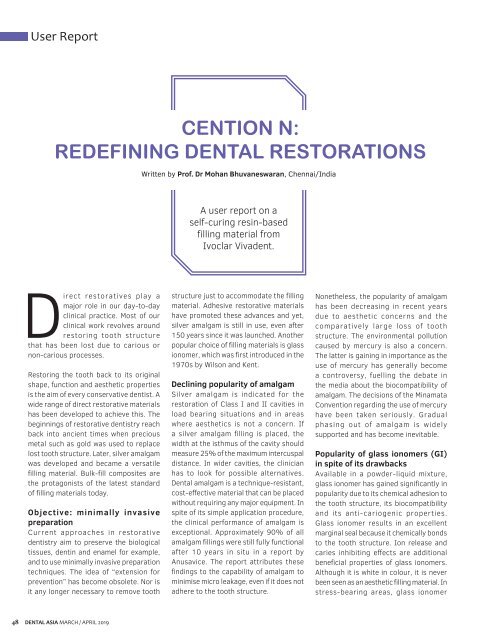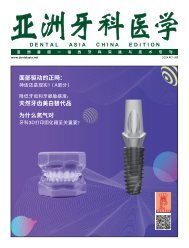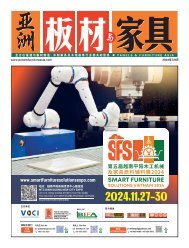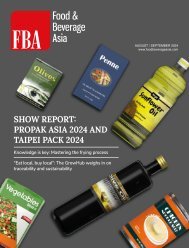Dental Asia March/April 2019
For more than two decades, Dental Asia is the premium journal in linking dental innovators and manufacturers to its rightful audience. We devote ourselves in showcasing the latest dental technology and share evidence-based clinical philosophies to serve as an educational platform to dental professionals. Our combined portfolio of print and digital media also allows us to reach a wider market and secure our position as the leading dental media in the Asia Pacific region while facilitating global interactions among our readers.
For more than two decades, Dental Asia is the premium journal in linking dental innovators
and manufacturers to its rightful audience. We devote ourselves in showcasing the latest dental technology and share evidence-based clinical philosophies to serve as an educational platform to dental professionals. Our combined portfolio of print and digital media also allows us to reach a wider market and secure our position as the leading dental media in the Asia Pacific region while facilitating global interactions among our readers.
Create successful ePaper yourself
Turn your PDF publications into a flip-book with our unique Google optimized e-Paper software.
User Report<br />
CENTION N:<br />
REDEFINING DENTAL RESTORATIONS<br />
Written by Prof. Dr Mohan Bhuvaneswaran, Chennai/India<br />
A user report on a<br />
self-curing resin-based<br />
filling material from<br />
Ivoclar Vivadent.<br />
Direct restoratives play a<br />
major role in our day-to-day<br />
clinical practice. Most of our<br />
clinical work revolves around<br />
restoring tooth structure<br />
that has been lost due to carious or<br />
non-carious processes.<br />
Restoring the tooth back to its original<br />
shape, function and aesthetic properties<br />
is the aim of every conservative dentist. A<br />
wide range of direct restorative materials<br />
has been developed to achieve this. The<br />
beginnings of restorative dentistry reach<br />
back into ancient times when precious<br />
metal such as gold was used to replace<br />
lost tooth structure. Later, silver amalgam<br />
was developed and became a versatile<br />
filling material. Bulk-fill composites are<br />
the protagonists of the latest standard<br />
of filling materials today.<br />
Objective: minimally invasive<br />
preparation<br />
Current approaches in restorative<br />
dentistry aim to preserve the biological<br />
tissues, dentin and enamel for example,<br />
and to use minimally invasive preparation<br />
techniques. The idea of “extension for<br />
prevention” has become obsolete. Nor is<br />
it any longer necessary to remove tooth<br />
structure just to accommodate the filling<br />
material. Adhesive restorative materials<br />
have promoted these advances and yet,<br />
silver amalgam is still in use, even after<br />
150 years since it was launched. Another<br />
popular choice of filling materials is glass<br />
ionomer, which was first introduced in the<br />
1970s by Wilson and Kent.<br />
Declining popularity of amalgam<br />
Silver amalgam is indicated for the<br />
restoration of Class I and II cavities in<br />
load bearing situations and in areas<br />
where aesthetics is not a concern. If<br />
a silver amalgam filling is placed, the<br />
width at the isthmus of the cavity should<br />
measure 25% of the maximum intercuspal<br />
distance. In wider cavities, the clinician<br />
has to look for possible alternatives.<br />
<strong>Dental</strong> amalgam is a technique-resistant,<br />
cost-effective material that can be placed<br />
without requiring any major equipment. In<br />
spite of its simple application procedure,<br />
the clinical performance of amalgam is<br />
exceptional. Approximately 90% of all<br />
amalgam fillings were still fully functional<br />
after 10 years in situ in a report by<br />
Anusavice. The report attributes these<br />
findings to the capability of amalgam to<br />
minimise micro leakage, even if it does not<br />
adhere to the tooth structure.<br />
Nonetheless, the popularity of amalgam<br />
has been decreasing in recent years<br />
due to aesthetic concerns and the<br />
comparatively large loss of tooth<br />
structure. The environmental pollution<br />
caused by mercury is also a concern.<br />
The latter is gaining in importance as the<br />
use of mercury has generally become<br />
a controversy, fuelling the debate in<br />
the media about the biocompatibility of<br />
amalgam. The decisions of the Minamata<br />
Convention regarding the use of mercury<br />
have been taken seriously. Gradual<br />
phasing out of amalgam is widely<br />
supported and has become inevitable.<br />
Popularity of glass ionomers (GI)<br />
in spite of its drawbacks<br />
Available in a powder-liquid mixture,<br />
glass ionomer has gained significantly in<br />
popularity due to its chemical adhesion to<br />
the tooth structure, its biocompatibility<br />
and its anti-cariogenic properties.<br />
Glass ionomer results in an excellent<br />
marginal seal because it chemically bonds<br />
to the tooth structure. Ion release and<br />
caries inhibiting effects are additional<br />
beneficial properties of glass ionomers.<br />
Although it is white in colour, it is never<br />
been seen as an aesthetic filling material. In<br />
stress-bearing areas, glass ionomer<br />
48<br />
DENTAL ASIA MARCH / APRIL <strong>2019</strong>


















